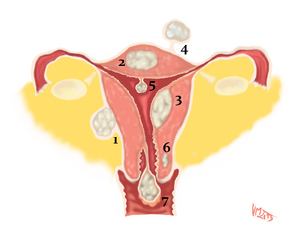Uterine myoma
Myomas(leiomyoma, English fibroid) re benign, monoclonal tumors of smooth muscle cellsthat grow from the muscle wall of intra-abdominal organs. In gynecology, we talk about a uterine myoma (the formation grows from the myometrium), in the digestive tract it is a myoma from the smooth muscle of the [[GIT] ]wall.
Myoma is most often encountered in gynecology - uterine myoma. Fibroids are the most common benign formation of the female genital tract. The prevalence of uterine fibroids is 20-30% in women under 30 and 50% in women over 30.
Uterine fibroids reach a size of 1 cm to (exceptionally) several decimeters. They can appear solitary, sometimes they are multiple - then we talk about myomatosis.
Fibroids are usually benign in nature. Malignant reversal of uterine myoma is rare.
Myoma is a hormone-dependent tumor - it contains hormone receptors - after menopause or after treatment with GnRH analogues, myomas regress.
Risk factors[edit | edit source]
Risk factors for the occurrence of uterine fibroids include genetic predisposition, hormonal influences and environmental influences.
Classification[edit | edit source]
The classification of uterine fibroids is determined by their location (submucous, intramural, subserosal fibroids) and their manifestation usually depends on the location.
Clinical picture[edit | edit source]
- It is determined by the size, location and number of fibroids;
- the most common symptoms – irregular uterine bleeding, pain and pressure in the lower abdomen;
- the bulging myoma compresses the endometrium – thus the vascularization is broken and the wall does not detach;
- large subserous ones can be asymptomatic and only bother with pressure or pain from necrotic changes inside the myoma;
- in fertile age myoma can be the cause of infertility or sterility;
- Fibroids usually grow faster during pregnancy.
The clinical picture can be completely asymptomatic (about 1/3 of women), or it manifests itself with typical symptoms, such as menstrual cycle disorders: hypermenorrhoea – excessive menstrual bleeding, menorrhagia – prolonged menstrual bleeding, dysmenorrhoea – painful menstrual bleeding. Fertile women may experience infertility.
Diagnostics[edit | edit source]
iagnosis is most often performed with the help of a gynecological examination, ultrasonography, hysteroskopy or as an operative finding.
Therapy[edit | edit source]
The therapy of uterine fibroids depends on the symptoms. We choose a conservative solution for asymptomatic fibroids (in 1/3 of women only monitoring is sufficient) and for women of childbearing age. When symptoms occur, surgical removal of myoma (hysteroscopic myomectomy, laparoscopic myomectomy, laparotomic myomectomy, laparoscopic uterine artery occlusion, myoma embolization) or hysterectomy is necessary. In certain cases, drug treatment may be indicated.
- For young women planning pregnancy:
- conservatively - i.e. remove the fibroid and leave the uterus;
- laparoscopic or hysteroscopic enucleation;
- preoperatively, large fibroids can be reduced with GnRH agonists (treatment 3–5 months)
- However, they most often appear in women who are no longer planning to become parents:
- with heavy bleeding, with pain, with rapid growth - hysterectomy
Links[edit | edit source]
Related Articles[edit | edit source]
External links[edit | edit source]
- BENEŠ, Jiří. Studijní materiály [online]. [cit. 2018-01-06]. <http://jirben2.chytrak.cz/>.
References[edit | edit source]
- MÁRA, Michal – HOLUB, Zdeněk. Děložní myomy : Moderní diagnostika a léčba. 1. edition. Grada, 2009. ISBN 978-80-247-1854-5.
- VOKURKA, Martin – HUGO, Jan. Velký lékařský slovník. 9. edition. Maxdorf, 2009. pp. 1159. ISBN 978-80-7345-202-5.
- HOLUB, Zdeněk – KUŽEL, David. Minimálně invazivní operace v gynekologii. 1. edition. Grada, 2007. ISBN 80-247-0834-5.


